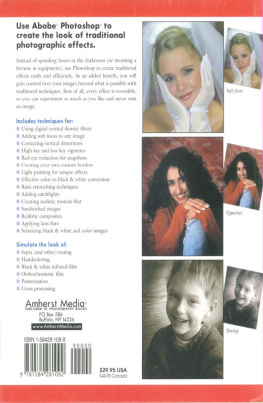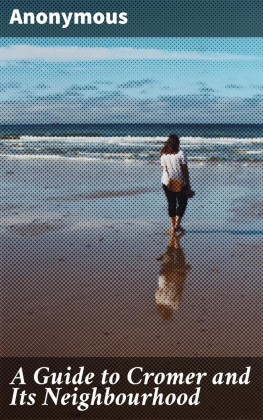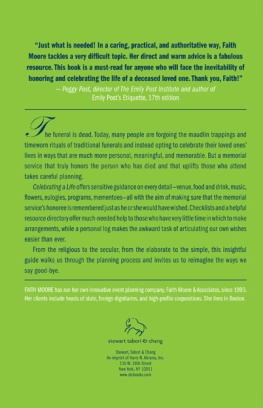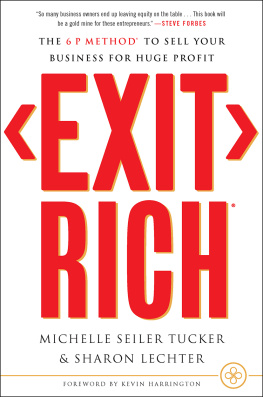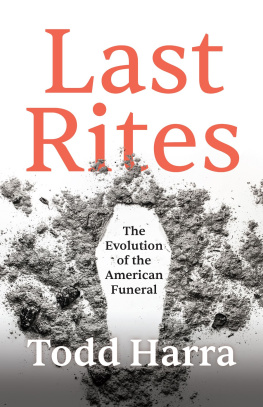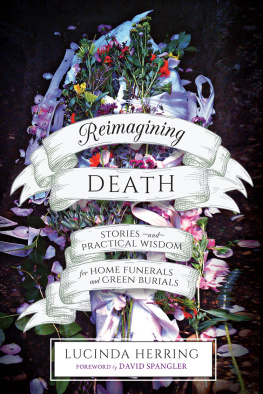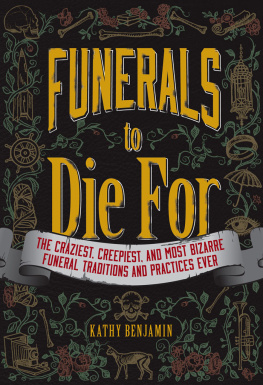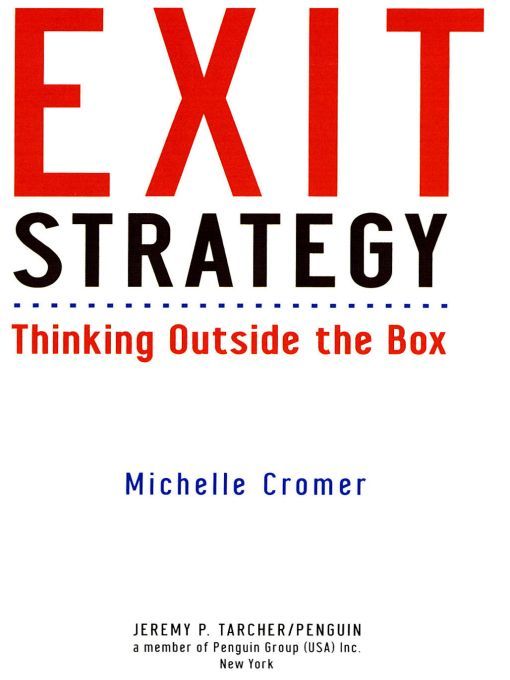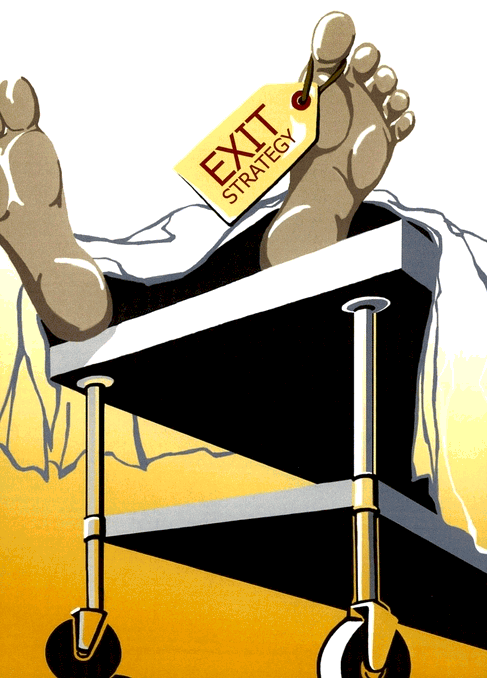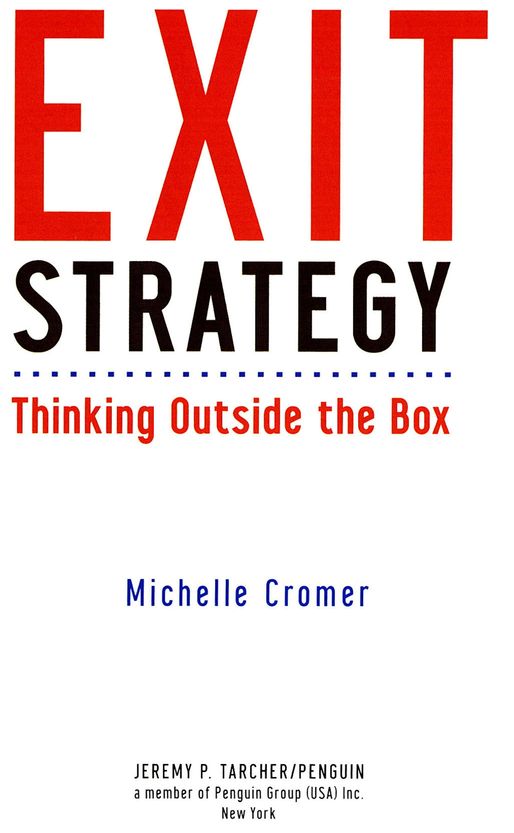Table of Contents
For Barry,
for our boys,
August and Sam,
and
in memory of Catalina
ACKNOWLEDGMENTS
My first thanks go to Francine Maroukian: if it were not for you and your idea to make a chapter into a book, I would not have written Exit Strategy.
Charles Burkhalter, my great friend and agent, thank you for selling me, a first-time author, and this book to the second-largest publishing company in the world.
Ken Siman, my editor at Tarcher/Penguin, thank you for agreeing to meet me for breakfast in May 2003, and for all of your advice on the publishing world. Thank you for believing in me, for your wise words, and for your constant help. I will never forget what you have done for me.
To Laura Lindgren, Ken Swezey, David Pfendler, thanks for bringing your vast professional talents to my team. A huge Muchas gracias to John Strausbaugh for sharing your brain with me and for teaching me how to write a good book on time, with passion.
Thanks to all the people I interviewed, especially Beth Menczer, Jay Murphy, Don Brawley, George Frankel, and Corky Ra. And to Norma Garber and Kristen and Jessica Jernigen for sharing such personal moments with me.
Of my friends and family who allowed me to stay with them or share a meal as I traveled to interviews, I thank Carolyn and Ron Smith, Garry Kershaw, Cathy and Drew Rosen, Christopher Barbour, Jonathan Gibbs, and in particular my father-in-law, Jim Cromer, who let me stay in Naples twice, flew to Key West for my interview, paid for everything, and threw two fabulous dinner parties, of course.
I have many friends to thank. Park Kerr, for introducing me to Francine. Perla Maldonado, for being with me at the beginning of this journey, and for our friendship. Rhonda Dore, for telling me to just write like I talkgreat advice. Alice White and Amy Hussmann, for sharing your fathers story and for all the phone calls, wine, and encouragement. Bob Wingo, my friend and business partner, for teaching me how to think outside the box for twenty years. Soffia Wardy, Valorie Montoya, Julian Garcia, Toni Dake, Tim and Patti Gallegly, Ron and Debbie Vernon, Monte and Shannon Batson, Nancy Cromer, Ron Fritsch, Carlos Veytia, Marc Beaudin, Edie Correa, and Jeri Baker. And Lupita and Ludy, for picking up my cleaning, the boys, the slack, and my spirit.
To my parents, Jim and Jenny Batson, thanks for giving me my work ethic and for teaching me that a soul is not something you have, it is what you are. And to Felicia Hopkins, thanks for nurturing my soul every Sunday.
My boys, August and Sam, thank you for understanding that I am not a conventional mother and for being so smart and so kind. I am proud of you both.
And to my husband, Barry: I could not have written this book without you. I am grateful for your patience, support, friendship, loyalty, and love. I am forever changed because of who you are and what you mean to me. Con amor, siempre tuya.
INTRODUCTION
On September 5, 2001, my son Sam was born, prematurely and as sick as could be. His nurse, who had evidently honed her bedside manner at a Marine boot camp, flatly told me that he wasnt going to live. A priest giving last rites to the baby next to him took one look at Sam and asked if I wanted him to give Sam last rites, too.
Death is not something I had thought about a great deal. My parents are still living, as are all of my siblings; at the time, so were all of my friends. As for me, I was healthy and had no intention of dying anytime soon, thank you. But as the hours stretched into days and then weeks and Sam continued to struggle for life, the death of a loved one became something I had to confront seriously for the first time.
Sam made it out, Nurse Ratched got fired, and I started to do a great deal of thinking about death and dying. My friends parents began to pass away, and as I went to their funerals I noticed that there was something unique about each ceremony. In our parents day, all funerals were pretty much the same, because grief-stricken families usually left matters to the funeral director and the minister, priest, or rabbi to do the organizing and set the tone. Everything was done according to tradition and ritual. What I noticed now was that my friends were taking more of a hand in crafting the ceremony, giving each loved ones send-off an individual flair and personal meaning.
Leave it to my generation, the baby boomers, to take control. Were not only organizing our parents funerals, but even planning our own in advance, putting our requests in writing and letting everyone know exactly what we want. Were a demographic so totally accustomed to center stage that we will never give it up without some fanfare. I first noticed this in Lawrence Kasdans 1983 homage to my generation, The Big Chill. After the priest announces that a college friend will play one of the deceaseds favorite songs, JoBeth Williamss character, Karen, solemnly sits down at the church organ and hits the classic opening chords of the Rolling Stones You Cant Always Get What You Want. As that sixties anthem accompanied the funeral procession, I wasnt the only boomer in the audience who thought, Now thats the way to go out. In 2005, Hunter S. Thompson, legendary gonzo journalist and counter-culture hero of my generation, even left behind a demand for his ashes to be shot out of a cannona plan made possible by his friend Johnny Depp, the actor who portrayed Thompson in the film version of his famous book Fear and Loathing in Las Vegas.
With baby boomers pushing up the average age in the United States, death care has grown into a $16 billion industry since the mid-1980s, a trend expected to continue through 2012. It has also been consolidating, as corporate chains have bought up some 20 percent of the nations funeral homes, with the rest remaining independent and family-run, like the one in Six Feet Under.
Whereas the vast majority of their parents simply put themselves and their loved ones in the hands of their local funeral director when the time came, boomers are taking a much more active role in the planning. And when members of the biggest consumer-driven generation in history pick up their platinum cards and commence to plan their own funerals with the kind of verve and zeal once reserved for prom night, you can bet that boomers are causing not just growth but change in the funeral business. This trendreferred to as self-planning is widespread and growing. For the first time in their industrys history, the nations 25,000 funeral directors have to think about how to market themselves to us. Theyre offering us choices and options in everything from casket styles to burial sites, disposal of cremated remains, and a variety of personalized funeral and memorial services.
Because Im a planner by natureI dont leave the drive-way without an agenda and a mapI started to think ahead to my own passing. I hope thats far in the future, but I figure its never too early to start shopping around. I began to research my options, and Exit Strategy shows the results. As I traveled around, I found people all over the United States exploring new, creative alternatives to traditional funeral and burial practices. I found that cremation, an option chosen by only about 5 percent of Americans thirty years ago, is a growing trend. I talked to visionary businesspeople and artists who will shoot my cremated remains into space, pack me into a golf club, mummify me, or turn me into a one-carat diamond (a choice so irresistible I have decided to make my husband, Barry, into a fabulous bracelet ... someday). I met families whose loved ones had conscientiously planned in advance to become part of an eco-friendly reef or forest, part of a growing green burial movement. I interviewed people who will be deep-frozen when they die, gambling that, at some point in the future, medical science will be able to revive them. Asking our parents what they want has become polite dinner conversation.


